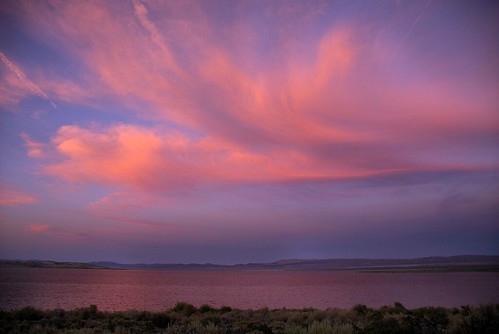On Flickr, Nadine comments about this photo “I don’t know if you had a chance to witness such beauty or whether you created this awesome image…”
It’s not at all unreasonable to suspect me, as Nadine does, of partially concocting imagery. After all, I believe that any interesting digital photograph is created using one part photography and one part post-processing tools. Nadine herself aptly summed up a recent essay of mine, A Pixel Is a Pixel, about digital manipulation as folows: “ALL digital images are manipulated.”
Point granted. Even the act of creating a JPEG using an automatic point-and-shoot involves digital manipulation, although the manipulation is performed by software, and most of us don’t think about it as manipulation. At a different level, most professional digital photographs have been at least routinely balanced and sharpened.
Along with the premise that all digital images are manipulated, I have two related hobby horses. First, I don’t want to see basic photography skills, and ways of seeing, lost in the oncoming rush of all things digital. And finally, it is clear (at least for me) that digital photography is now a bifurcated craft, blending the job of the photographer with that of a digital technician.
For myself, though, the scene I photograph needs to contain the seed of the final image, in the sense that the child is the father of the man, or what I create ultimately is some kind of Platonic ideal of what I saw when I photographed. There’s always a connecton between my subject matter and the final image, even if I do use digital techniques to fix flaws and make the scene grander.
Here’s the backstory of this photograph of sunset at Mono Lake. Julian and I were hanging out at the South Tufa Area around sunset. Julian was playing on the beach and I was taking pictures.
The light was beginning to fade, and I was just about to pack it in. I looked up and saw a large cloud start to glow with the sunset. I grabbed Julian, my camera, and tripod, and ran for the car. I figured I’d get to higher ground where I could capture the light from the cloud reflected in the lake.
This plan worked although as it turned out by the time I got to a good vantage point I only had a few seconds before the sunset faded, so I was only able to snap a couple of quick photos. This one was handheld at 1/20 of a second, which I only got away with because it was a wide angle view, and thanks to the len’s Vibration Reduction (image stabilization) feature.
How vast Mono Basin seemed in the oncoming night alone with my nine-year-old as I took this picture! How wonderful, savage, lonely and beautiful.
Back at the computer, I multi-processed the RAW original, “painting in” varying exposures using layer masks and the Photoshop Paintbrush tool to increase the vibrancy and the cloud and the water color, and to make the photo look more like the scene the way I remembered it.

Pingback: Photoblog 2.0: » Photoblog 2.0 Archive: » When Virtual Worlds Collide